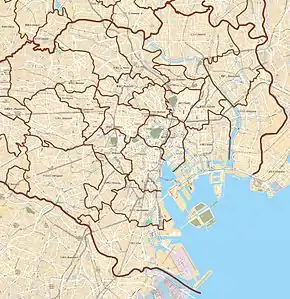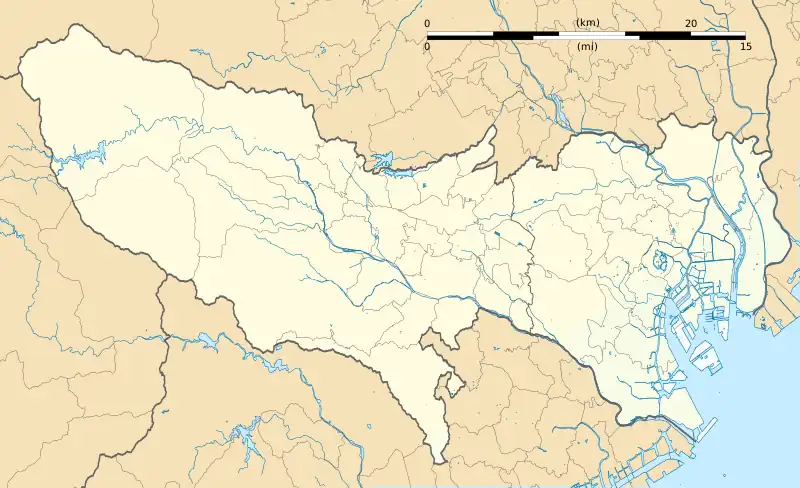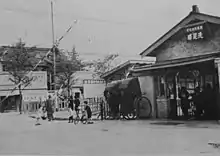MG05 Senzoku Station 洗足駅 | |||||||||||
|---|---|---|---|---|---|---|---|---|---|---|---|
 Senzoku Station in July 2012 | |||||||||||
| General information | |||||||||||
| Location | 2-21-1 Senzoku, Meguro-ku, Tokyo Japan | ||||||||||
| Operated by | |||||||||||
| Line(s) | |||||||||||
| Distance | 6.5 km (4.0 mi) from Meguro | ||||||||||
| Platforms | 2 side platforms | ||||||||||
| Tracks | 2 | ||||||||||
| Construction | |||||||||||
| Structure type | Underground | ||||||||||
| Other information | |||||||||||
| Station code | MG05 | ||||||||||
| Website | Official website | ||||||||||
| History | |||||||||||
| Opened | 11 March 1923 | ||||||||||
| Passengers | |||||||||||
| FY2018 | 15,146 daily | ||||||||||
| Services | |||||||||||
| |||||||||||
| Location | |||||||||||
 Senzoku Station Location within Special wards of Tokyo  Senzoku Station Senzoku Station (Tokyo Bay and Bōsō Peninsula)  Senzoku Station Senzoku Station (Tokyo)  Senzoku Station Senzoku Station (Japan) | |||||||||||
Senzoku Station (洗足駅, Senzoku-eki) is a railway station on the Tokyu Meguro Line in Meguro, Tokyo, Japan, operated by the private railway operator Tokyu Corporation.
Lines
Senzoku Station is served by the Tokyu Meguro Line, and lies 6.5 km from the starting point of the line at Meguro. Only "Local" all-stations services stop at this station.
Station layout
This station consists of two opposed side platforms serving two tracks.
Platforms
| 1 | ■ Tokyu Meguro Line | for Ookayama, Hiyoshi, Shin-Yokohama, and Futamatagawa |
| 2 | ■ Tokyu Meguro Line | for Meguro, Akabane-iwabuchi, Urawa-misono, and Nishi-takashimadaira |
History

The station opened on 11 March 1923.[1] It was developed as an anchor of the Senzoku Garden City, which was itself named after the nearby Senzoku Pond (the namesake of Senzoku-ike Station on the Ikegami Line, about 1 km away).
Although the tracks were originally at street level, they were moved underground in 1967 in order to avoid a level crossing of Kannana-dori, a major prefectural highway located to the west of the station. The next station inbound, Nishi-koyama, was moved underground in 2006, and the northeast side of Senzoku was reconfigured with a new footbridge with elevators to allow traffic to cross.
Passenger statistics
| Year | Ridership |
|---|---|
| 2010 | 14,085[2] |
| 2011 | 14,165[3] |
| 2012 | 14,311[4] |
| 2013 | 14,481[5] |
| 2014 | 14,499[6] |
| 2015 | 14,630[7] |
| 2016 | 14,863[8] |
| 2017 | 14,903[9] |
| 2018 | 15,146[10] |
Surrounding area
- Showa University Senzoku Campus
- Kita-Senzoku Station (Oimachi Line)
See also
References
- ↑ Terada, Hirokazu (19 January 2013). データブック日本の私鉄 [Databook: Japan's Private Railways]. Japan: Neko Publishing. p. 231. ISBN 978-4-7770-1336-4.
- ↑ "TOKYU CORPORATION 2011-2012". www.tokyu.co.jp. Retrieved 2020-03-18.
- ↑ "TOKYU CORPORATION 2012-2013". www.tokyu.co.jp. Retrieved 2020-03-18.
- ↑ "TOKYU CORPORATION 2013-2014". www.tokyu.co.jp. Retrieved 2020-03-18.
- ↑ "TOKYU CORPORATION 2014-2015". www.tokyu.co.jp. Retrieved 2020-03-18.
- ↑ "TOKYU CORPORATION 2015-2016". www.tokyu.co.jp. Retrieved 2020-03-18.
- ↑ "TOKYU CORPORATION 2016-2017". www.tokyu.co.jp. Retrieved 2020-03-18.
- ↑ "TOKYU CORPORATION 2017-2018". www.tokyu.co.jp. Retrieved 2020-03-18.
- ↑ "TOKYU CORPORATION 2018-2019". www.tokyu.co.jp. Retrieved 2020-03-18.
- ↑ "TOKYU CORPORATION 2019-2020". Retrieved 18 Mar 2020.
External links
- Official website (in Japanese)